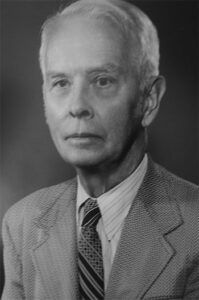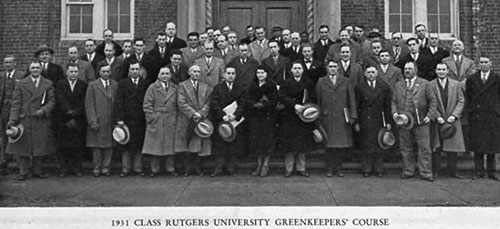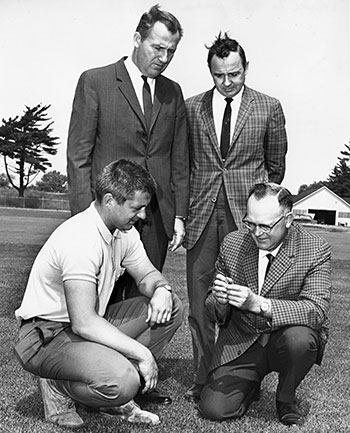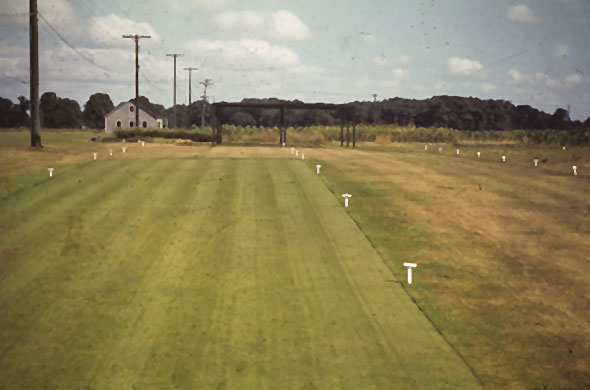Main Content

The New Jersey Agricultural Experiment Station (NJAES) has a long and distinguished history of providing turfgrass research, education and service programs in support of the turfgrass industry in the state, region and nation. The first turfgrass evaluation plots were established at the NJAES in 1923 under the leadership of G. W. Musgrave to determine the adaptability of Virginia, Metropolitan, and Washington bentgrass cultivars for golf courses in New Jersey (2, 6). In 1925, additional studies were established by Musgrave and doctoral student H. B. Sprague with financial support from the Green Section of the United States Golf Association (2, 4, 6).
Dr. Sprague pioneered the establishment of the turfgrass research and extension program at Rutgers University and served as its first full-time turf faculty member from 1927-1942 (1, 2). He was an incredibly productive researcher who released the first turfgrass variety from the NJAES (‘Raritan’ velvet bentgrass) in 1940 (2, 3). Sprague was president of the Crop Science Society of America (1960) and the Agronomy Society of America (1964), and published five turf management books over a career that spanned more than 55 years.
After an unusually hot, wet summer in 1928 resulted in extensive turf loss on poorly drained annual bluegrass greens throughout the state, the State of New Jersey appropriated funds to increase the size of the turf research facility at the NJAES. This allowed the emerging turf team of Sprague, Musgrave, E. E. Evaul, T.C. Longnecker, H. R. Cox, and other well-known names on today’s Cook Campus such as J.C. Lipman (Lipman Hall), R.L.Starkey (Starkey Apartments), and F.G. Helyar (Helyar House) to greatly expand their research and outreach efforts.

The Rutgers turf program has the distinction of having hosting the nation’s first turf field day and first turfgrass conference in 1928 (1). The following year it also initiated a five-day Turf Short Course that educated hundreds of turf managers from throughout the Tri-State Region between 1929 and 1957.
After World War II, the turfgrass program at Rutgers was re-established under the leadership of Dr. R.E. Engel was hired as a full-time turf faculty member (with a 50% research and 50% extension appointment) to replace H. B. Sprague in 1947. Dr. Engel was a superb researcher whose career at Rutgers spanned more than 40 years and who contributed to many of the basic principles on which turfgrass management is based today. He was instrumental in establishing the 10-week Winter Turf Course in 1946, as well as the two-year Professional Golf Turf Management School in 1962 which has educated thousands of young men and women from throughout the United States and abroad. Dr. Engel also established the golf course visitation service for the metropolitan area, a progenitor of the current USGA Greens Section Turf Advisory Service.
In the 1950s, the Rutgers Turfgrass Program really started to expand. In 1956, Dr. Richard Skogley was hired as a full-time turfgrass extension specialist thus freeing up Ralph Engel to concentrate more on research and teaching. The following year Dr. Richard Ilnicki was hired as a research professor in weed scientist, followed by Dr. John Meade as the extension weed scientist in turf and ornamentals. Dr. Louis Vasvary soon joined the turf team as the extension turf and ornamentals entomologist, as did Dr. Robert Duell who worked extensively on the management of low maintenance turf for roadsides in the state.

In 1960, Dr. Henry Indyk was hired as the extension specialist in turfgrass management when Dr. Skogley left Rutgers to lead the turf program at the University of Rhode Island. Dr. Indyk helped form the Cultivated Sod Association of New Jersey in 1962, the New Jersey Turfgrass Association in 1970, and was the driving force behind the development of the annual New Jersey Turfgrass Expo educational conference and trade show in 1974. He was also a strong advocate for the certification of seeded turfgrass varieties, and initiated a sod certification program in New Jersey, the first of its kind in the United States.
The turfgrass breeding program took a giant step forward when Dr. C. Reed Funk joined the faculty in 1962. At the same time, the University purchased a 200 acre dairy farm in Freehold, NJ to support the new breeding program as well as applied research in cereal crops, forages, and field crops. The first field day was held at the new Plant Science Research and Extension Farm (known as the Adelphia Farm) in 1965. Dr. Funk was a pioneer in turfgrass breeding and was the first full-time cool-season turfgrass breeder in the United States. He helped shape the turfgrass team that is in place today and had an incredibly productive career that spanned over four decades.
Funk is credited with the development of hundreds of cool-season turfgrass cultivars with dramatic improvements in pest and stress tolerance. Many of his germplasm releases, such as ‘Manhattan’ perennial ryegrass and ‘Rebel’ tall fescue, are considered landmark cultivars and have served as a foundation for many of the new turf-type cultivars used throughout the world today. His tremendous intellect and keen sense of observation lead to many significant discoveries including the development of the first successful method of breeding Kentucky bluegrass by means of intraspecific hybridization, and the discovery that endophytic fungi can impart increased tolerance to major insect pests and enhanced performance for turfgrasses growing under environmental stress. Reed’s diverse germplasm collection and enhancement programs have revolutionized the turfgrass sod and seed industries throughout the world.

Dr. Philip Halisky joined the turfgrass team in the mid-1960s as a research professor in turfgrass pathology specializing in Helminthosporium diseases of cool-season turf. Halisky conducted research and taught in the two-year Professional Golf Turf Management School for more than 20 years and was an expert on smut diseases of grasses.
By the 1980, Rutgers was a recognized a world-leader in turf research and extension. The program had outgrown its research farm on the corner of Dudley Rd. and College Farm Rd., so the entire operation was moved to Horticulture Farm 2 in North Brunswick in 1982. Dr. Bruce Clarke was hired in 1981 to replace Dr. Spence H. Davis, the extension specialist in turf and ornamental pathology. To expand on that reputation, Dr. Clarke worked with Dr. Richard H. White, turfgrass physiologist at Rutgers from 1987 to 1992, and the rest of the turfgrass faculty to develop a strategic plan in 1987 that set the stage for hiring nine new faculty over the next two decades, including: Dr. James Murphy, extension specialist in turfgrass management (1991), Dr. James White, research professor in endophyte systematics (1995), Dr. Michael Richardson, turfgrass physiologist (1995-1997), Dr. William Meyer, turfgrass breeder (1996), Dr. Albrecht Koppenhöfer, turfgrass entomologist (1998), Dr. Steven Hart, turfgrass weed scientist (1999-2014), Dr. Bingru Huang, turfgrass stress physiologist (2000), Dr. Stacy Bonos, turfgrass breeder (2001), and Dr. Ning Zhang, a research professor working with plant-associated fungi. Clarke became the director of the Rutgers Center for Turfgrass Science in 1993, a position he held until the end of 2020, with Dr. James Murphy taking the helm in 2021.
The Rutgers Center for Turfgrass Science currently has 22 faculty, eight adjunct faculty, and more than 50 graduate students, post-doctoral fellows and staff. The core mission of the Turfgrass Center is to generate and disseminate new knowledge and to provide training and education in the turfgrass sciences by fostering internationally recognized, multidisciplinary research, undergraduate, graduate, and continuing professional education, and service programs in support of the turfgrass industry. The central theme for turfgrass research in the Center encompasses germplasm enhancement and turfgrass management. Current studies include developing grasses with better stress tolerance and pest resistance, host-endophyte associations; sustainable turf management, chemical and biological control of insects, weeds and diseases to reduce pesticide inputs; management of the annual bluegrass weevil, developing best management practices for foliar and root diseases, and turfgrass response to traffic, soil and low input management.
The breeding team led by Dr. Stacy Bonos has continued to expand the world famous turfgrass breeding program established by Reed Funk. The turfgrass breeding program interacts very closely with all faculty in the Turf Center, especially Dr. James Murphy as head of the turf management program and Dr. Bingru Huang in the area of stress physiology. Since 1996, extensive collection trips to Western and Eastern Europe have generated over 10,000 new germplasm sources (personal communications W. Meyer) for the Rutgers Turfgrass Program. This has resulted in the largest collection of cool-season turfgrasses in the world. Continuing the germplasm collection and population improvement programs at Rutgers will ensure a continuous stream of cultivars with improved pest and stress tolerance and exceptional turfgrass quality in the future.
References
- Beard, J.B., H.J. Beard, and J.C. Beard. 2013. Turfgrass History and Literature: Lawns, Sports, and Golf. Michigan State University Press, East Lansing, MI 648 pp.
- Engel, R.E., and E.E. Evaul. 1948. The history of turf at the New Jersey Agricultural Experiment Station. The Greenkeepers’ Reporter. 16(1): 22, 23. 38-41.
- Funk, C.R., and W.A. Meyer. 2001. Seventy years of turfgrass improvement at the New Jersey Agricultural Experiment Station. in: Page 39 in Proc. Annual Rutgers Turfgrass Symp., 10th. A. Koppenhofer and B. Fitzgerald eds. Center for Turfgrass Science, Rutgers, The State University, New Brunswick, N.J.
- Musgrave, G.W. 1926. Rep. Dep. of Agron. Miscell. Rep. New Jersey State Agric. Exp. Stn., 1025 46:275.
- Sprague, H.B. 1928 Turf experiments at the New Jersey state station. Bull. USA Green Section 8(12):251-252.
- Sprague, H.B., and E.E. Evaul. 1930. Experiments with turf grasses in New Jersey. New Jersey Agric. Exp. Stn. Bull. 497.



